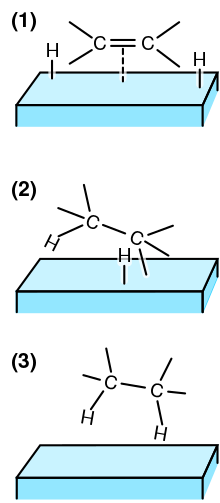수소화

(1) 반응물이 촉매 표면에 흡착되어 H2가 해리된다.
(2) H 원자는 C 원자에 결합한다. 다른 C 원자는 여전히 표면에 붙어 있다.
(3) 두 번째 C 원자는 H 원자와 결합한다. 분자는 표면을 이탈한다.
수소화(水素化, 영어: hydrogenation)는 일반적으로 니켈, 팔라듐, 백금과 같은 촉매의 존재 하에 수소 분자(H2)와 다른 화합물 또는 원소 간의 화학 반응이다. 수소화는 일반적으로 유기 화합물을 환원시키거나 포화시키는 데 사용된다. 수소화는 일반적으로 분자, 종종 알켄에 수소 원자 쌍을 첨가시킨다. 이러한 반응에는 촉매가 필요하다. 비촉매 수소화는 매우 높은 온도에서만 일어난다. 수소화는 탄화수소의 이중 결합 및 삼중 결합을 환원시킨다.[1]
19세기 말, 프랑스의 화학자 폴 사바티에(Paul Sabatier)가 고온에서 유기물에 수소를 혼합하는 수소화 기법을 개발했다.[2]
같이 보기[편집]
각주[편집]
- ↑ Hudlický, Miloš (1996). 《Reductions in Organic Chemistry》. Washington, D.C.: American Chemical Society. 429쪽. ISBN 978-0-8412-3344-7.
- ↑ Jackson & List (2007). "Giants of the Past: The Battle Over Hydrogenation (1903–1920)", Inform 18........Hydrogenation of organic substances in the gas phase was discovered by Sabatier in the latter part of the 19th century and applications to the liquid phase had been patented by Normann both in Britain and Germany in 1903. The British firm of Joseph Crosfield and sons, who acquired the rights to the Normann patent, began an extensive campaign to interest European soap manufacturers in the technology, hoping to sell the patent rights for profit. According to Joseph Wilson (The History of Unilever in two volumes), the struggle over the Normann patents in Europe were equally intense as the litigation in America that followed. By 1907, Crosfield had carried out sufficient research to bring their hydrogenation technology to the United States. By November 1907, Edwin Kayser, a Crosfield chemist, took up residence in Cincinnati, Ohio and, shortly thereafter, contacted John Burchenal, business manager of Proctor and Gamble. By early January 1908, a business arrangement had been made. Kayser then filed two U. S. patents applications; (U.S. 1,004,034, Process for Making Metallic Catalysts and U.S. 1,004,035, Method for Saturating Fatty Acids or their Glycerides with Hydrogen, granted September 11, 1911). Both patents were assigned to Proctor and Gamble Co., Cincinnati, Ohio. There can be little doubt that, at this point, the goal was to completely harden oils for the express purpose of producing raw materials for soap making. The work was kept secret except for Burchenal, Kayser and Wallace Macaw, whose company (Georgia Mills and Elevator Company) had been acquired through a merger with Proctor and Gamble. By late 1910, John Burchenal had filed two U.S. patent applications (Food Products 1,135,351 and 1,135,951, both granted April 13, 1915). Note that about five years elapsed from the time that the patents were applied for until their issuance. The former is based on partial hydrogenation of cottonseed while the latter is based on blending completely hydrogenated cottonseed oil with liquid cottonseed oil. Originally, the product was named "Krispo" followed by "Crsyt," but settled for Crisco (an acronym for crystallized cottonseed oil) because of trademark and for obvious religious reasons.
